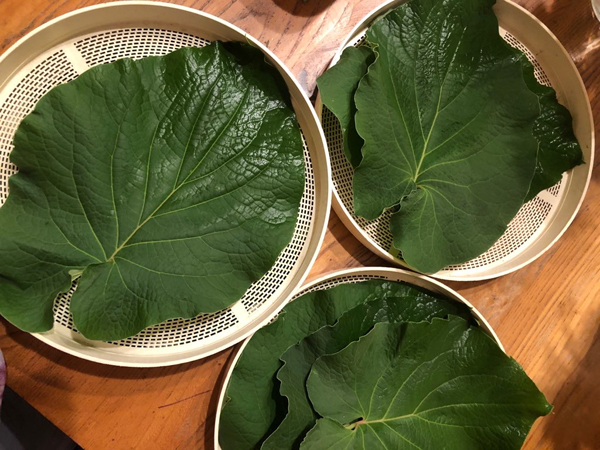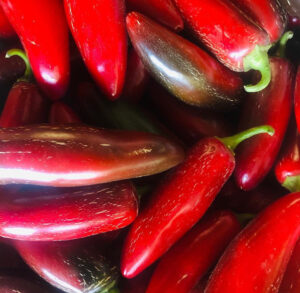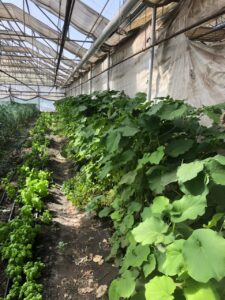Yerbas Buenas

Starling is drying bales of Hoja Santa in the food dehydrator so our kitchen is enveloped in an aromatic, herbal haze, prompting me to think about breakfast, lunch, and history. Let’s look at the past before the repast.
History is written by the victors, not the victims, so when I was in kindergarten Columbus “discovered” America. Maybe it’s more accurate to say that history is “rewritten” by the victors. Our past is constantly undergoing reinterpretation as new information comes to light or as we mature enough as a community to look at the old facts in a new way. Also, the oppressed voices of previous generations don’t necessarily remain silenced forever. If a defeated community regains its sense of worth, then it’s natural that the people in it will begin to push back against a dominant culture’s version of history that chooses to ignore their past accomplishments, demean their historic role in creating our present or minimize their right to participate in planning our future. That’s where we’re at today in America, with a fraying establishment’s narrative undergoing some timely and therapeutic re-examination. If your sense of self-worth depends on a historical order that’s under re-evaluation then critical scrutiny by contemporary historians can feel like an attack. A foolish yet natural response of the frightened ignorati is to attack the messenger for bringing the news. So, for example, as the 1619 Project encourages us to reexamine our nation’s history of slavery and racism, it’s getting common to hear slurs being lobbed at the historians who would dare to take another look at our shared past – “communists, anarchists, socialists, liberals, terrorists, snowflakes, etc.” Universities get the brunt of the abuse because they are the vectors of learning and new ideas. But history isn’t just academic; it’s as down and flavorful as the crops in our fields or the food on our plates.
 Of course, the myth of Columbus was always an odd half truth. It’s not only that the millions of people already living in the Americas in 1492 didn’t need Columbus to “discover” them in order to exist. Columbus crashed into America. He misunderstood the lands that he encountered upon crossing the Atlantic to BE India. But lots of money was at stake. The lucrative trade in Black pepper, Piper nigrum, that motivated investors to bankroll Columbus’s radical voyage across the Atlantic to India, was too important to ignore. So, to satisfy investors the native Americans became “Indians.” Lacking real black pepper to return home with, Columbus loaded up a cargo of the dried, spicy chilies that the Native Americans were cooking with and called them “peppers.” The American Capsicum species are not related to the Piper nigrum peppercorns of the “Spice Islands” that Columbus thought he’d found his way to, but they are spicy. It’s interesting that once the Spaniards discovered the Pacific and crossed it to Asia the residents of the real Spice Islands were more delighted with the American chili “peppers” than the Europeans who’d “discovered” them were. You don’t want to make blanket declarations about any continent’s culture, but it is true that the chili pepper slipped into Asian cuisines very readily. Today there are many varieties of chili that have been selected and improved by Asian farmers, but they all have their roots in the Pre-Columbian agriculture of the Americas.
Of course, the myth of Columbus was always an odd half truth. It’s not only that the millions of people already living in the Americas in 1492 didn’t need Columbus to “discover” them in order to exist. Columbus crashed into America. He misunderstood the lands that he encountered upon crossing the Atlantic to BE India. But lots of money was at stake. The lucrative trade in Black pepper, Piper nigrum, that motivated investors to bankroll Columbus’s radical voyage across the Atlantic to India, was too important to ignore. So, to satisfy investors the native Americans became “Indians.” Lacking real black pepper to return home with, Columbus loaded up a cargo of the dried, spicy chilies that the Native Americans were cooking with and called them “peppers.” The American Capsicum species are not related to the Piper nigrum peppercorns of the “Spice Islands” that Columbus thought he’d found his way to, but they are spicy. It’s interesting that once the Spaniards discovered the Pacific and crossed it to Asia the residents of the real Spice Islands were more delighted with the American chili “peppers” than the Europeans who’d “discovered” them were. You don’t want to make blanket declarations about any continent’s culture, but it is true that the chili pepper slipped into Asian cuisines very readily. Today there are many varieties of chili that have been selected and improved by Asian farmers, but they all have their roots in the Pre-Columbian agriculture of the Americas.
 Corn, squash, beans, potatoes, tomatoes, tobacco, chili peppers, chocolate….; the Native American farmers cultivated so many plants that became major foods for the rest of the world that it’s interesting to look at the varieties that were not immediately adopted by the rest of the world. Ironically, one Native American garden plant that Columbus didn’t “discover” was actually a true pepper variety, related to the Piper nigrum that motivated the Spanish adventure in the Americas in the first place, Piper auritum. The leaves of this plant have a rich, anise-like scent. While the Piper auritum has many names across Latin America- “Anisillo,” “Tlanepa, “Acuyo”- one of the most common names is “Yerba Buena” or “Hoja Santa,” which means “Good Herb” or “Holy Herb.” One problem for food historians is that a wide range of desirable herbs have been called “Yerba Buena.” What’s now the City of San Francisco was once the village of “Yerba Buena,” for example, and the “good herb” in this case was a native California mint family member. If the historical revisionists reject the community’s present name “San Francisco” because it celebrates Catholicism I can see the town’s name reverting to “Good Herb,” but that’s another story.
Corn, squash, beans, potatoes, tomatoes, tobacco, chili peppers, chocolate….; the Native American farmers cultivated so many plants that became major foods for the rest of the world that it’s interesting to look at the varieties that were not immediately adopted by the rest of the world. Ironically, one Native American garden plant that Columbus didn’t “discover” was actually a true pepper variety, related to the Piper nigrum that motivated the Spanish adventure in the Americas in the first place, Piper auritum. The leaves of this plant have a rich, anise-like scent. While the Piper auritum has many names across Latin America- “Anisillo,” “Tlanepa, “Acuyo”- one of the most common names is “Yerba Buena” or “Hoja Santa,” which means “Good Herb” or “Holy Herb.” One problem for food historians is that a wide range of desirable herbs have been called “Yerba Buena.” What’s now the City of San Francisco was once the village of “Yerba Buena,” for example, and the “good herb” in this case was a native California mint family member. If the historical revisionists reject the community’s present name “San Francisco” because it celebrates Catholicism I can see the town’s name reverting to “Good Herb,” but that’s another story.
 I started growing Hoja Santa because Matt Gandin, the Chef at Comal in Berkeley, asked me for some. I didn’t know anything about the plant, but Fidel, our farm’s foreman in the greenhouse, was very familiar with the crop so I felt comfortable giving it a try. Our friend and neighbor, Don Pablo, has a nursery, El Capulin, that grows a wide range of ornamental and edible plants that he sells in farmers markets so he set us up with some plants and we were off and running. The Hoja Santa plants grow big and tall. They require some protection from the cold of winter but they’re pretty hardy. Fidel tells me that “every family” in Oaxaca has an Hoja Santa plant growing in their yard, so it’s not worth a farmer’s time to produce the crop for sale, but the leaves are used in daily cooking. The big, heart-shaped, aromatic leaves are used to wrap fresh cheeses and they lend their scent to the food. Sometimes the fresh leaves are used as wrappers for other foods too, the way that corn husks are used to wrap tamales. And the leaves are dried and crumbled too, for use in egg and bean dishes, in soups and in stews. Because the Hoja Santa has a sweetness to it there are also a number of drinks or cocktails that can be made using it’s flavoring. In my own kitchen I’ve used Hoja Santa to flavor scrambled eggs and quesadillas. When it’s not so hot outside and my mood turns more to soup I’ll try it in broths. This Friday I’m thinking I’ll try some Holy Leaf cocktails!
I started growing Hoja Santa because Matt Gandin, the Chef at Comal in Berkeley, asked me for some. I didn’t know anything about the plant, but Fidel, our farm’s foreman in the greenhouse, was very familiar with the crop so I felt comfortable giving it a try. Our friend and neighbor, Don Pablo, has a nursery, El Capulin, that grows a wide range of ornamental and edible plants that he sells in farmers markets so he set us up with some plants and we were off and running. The Hoja Santa plants grow big and tall. They require some protection from the cold of winter but they’re pretty hardy. Fidel tells me that “every family” in Oaxaca has an Hoja Santa plant growing in their yard, so it’s not worth a farmer’s time to produce the crop for sale, but the leaves are used in daily cooking. The big, heart-shaped, aromatic leaves are used to wrap fresh cheeses and they lend their scent to the food. Sometimes the fresh leaves are used as wrappers for other foods too, the way that corn husks are used to wrap tamales. And the leaves are dried and crumbled too, for use in egg and bean dishes, in soups and in stews. Because the Hoja Santa has a sweetness to it there are also a number of drinks or cocktails that can be made using it’s flavoring. In my own kitchen I’ve used Hoja Santa to flavor scrambled eggs and quesadillas. When it’s not so hot outside and my mood turns more to soup I’ll try it in broths. This Friday I’m thinking I’ll try some Holy Leaf cocktails!
The Hoja Santa plants stop growing and lose most of their leaves here during the cold weather or winter, so we’re drying what we can now while the plants are green and fluffy. We will be preserving other herbs too, as time allows. In the greenhouse we’re propagating more lemon verbena, oregano, marjoram, savory, thyme, rosemary, sage, nepitella, lavender and mints. We’ve been growing a lot of roses in the yard too- we’re up to over a hundred plants- with an eye to rose bouquets, rose petals, and rose hips. They’ve all got their uses in the kitchen and they’re all Yerbas Buenas.
© 2020 Essay by Andy Griffin. Photos by Andy Griffin and Starling Linden


